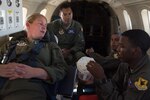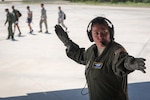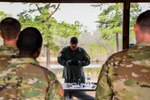| You are subscribed to News Articles for U.S. Department of Defense. This information has recently been updated, and is now available.
Crews Provide Aeromedical Evacuation Capabilities in Cope North Exercise
|
Month: February 2018
Guardsmen, First Responders Partner to Fight Synthetic Opioids
| You are subscribed to News Articles for U.S. Department of Defense. This information has recently been updated, and is now available.
Guardsmen, First Responders Partner to Fight Synthetic Opioids
|
U.S. Department of Defense Lead Photos Update
| You are subscribed to Lead Photos for U.S. Department of Defense. This information has recently been updated, and is now available.
Furry Five Kerry A. Welch, a USO representative, gets a high-five from his dog Lucy at Robert Gray Army Airfield, Texas, Feb. 25, 2018, in front of nearly 100 Army Reserve soldiers preparing to deploy to Southwest Asia. Army Reserve photo by Sgt. 1st Class Brent C. Powell |
Today in the Department of Defense, Mar. 1, 2018
| You are subscribed to Today in DoD for U.S. Department of Defense. This information has recently been updated, and is now available.
Today in the Department of Defense, Mar. 1, 2018 |
Contracts For Feb. 28, 2018
| You are subscribed to Contract Announcements for U.S. Department of Defense. This information has recently been updated, and is now available.
Contracts For Feb. 28, 2018 |
Stratcom Commander Discusses Strategic Deterrence Mission
| You are subscribed to News Articles for U.S. Department of Defense. This information has recently been updated, and is now available.
Stratcom Commander Discusses Strategic Deterrence Mission
|
||||||||||||||
myNRH Goes Live March 6th
| myNRH Goes Live March 6th!
myNRH will go live next Tuesday, March 6th! Those visiting the current Navy Reserve Homeport homepage at https://private.navyreserve.navy.mil/Pages/default.aspx will automatically be redirected to the new site. Go to https://www.myNRH.navy.mil to check out the Preview! Check out the launch trailer on YouTube!: https://www.youtube.com/watch?v=8w15HjaTvm8 myNRH transforms the homepage of Navy Reserve Homeport into a modernized and mobile-friendly site that Navy Reservists can easily access from any device, anytime, anywhere. The myNRH effort will enable Force communication capabilities in the form of alerts and messages similar to the alert capabilities resident in most modern mobile applications. myNRH provides access to public (non-CAC) content while Ready-2-Serve (R2S) will continue providing access to private CAC-enabled capabilities. – The Navy Reserve myNRH Team |
U.S. Department of Defense Lead Photos Update
| You are subscribed to Lead Photos for U.S. Department of Defense. This information has recently been updated, and is now available.
Cold Carry Marines move a mock hypothermic casualty during cold-weather training at the Black Rapids Training Site in Alaska, Feb. 20, 2018, to prepare for the upcoming Arctic Edge exercise. Army photo by John Pennell |
Flag Officer Assignments
| You are subscribed to News Releases for U.S. Department of Defense. This information has recently been updated, and is now available.
Flag Officer Assignments |
Join us for PSAW 2018!

Dear Patient Safety Champions, Patient Safety Awareness Week is almost here! This year we are focused on being “United for Patient Safety” March 11-17, 2018. Will you join us? There are lots of opportunities for health care professionals, patient safety champions, patients and their families to get engaged and learn about how they can reduce harm and ensure safe care delivery. Here’s how you can get engaged now:
Mark your calendars for these learning opportunities:
More information is available on our web site at www.health.mil/PSAW. Please e-mail us at DHA.patientsafety if you have any questions. We look forward to you joining us! Thank you, DoD Patient Safety Program Team |





